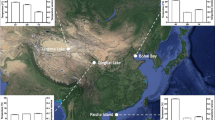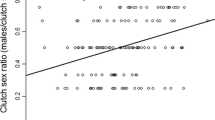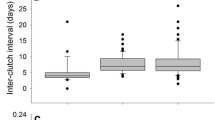Summary
There is evidence that the side-blotched lizard, Uta stansburiana, and some other organisms of temperate latitudes produce fewer and larger eggs as the reproductive season progresses. There are at least two models that could explain this phenomenon.
Proponents of the parental investment model claim that females are selected to increase egg size, at the cost of clutch size, late in the season in order to produce larger and competitively superior hatchlings at a time when food for hatchlings is in low supply and when juvenile density is high. In this model the selective agent is relative scarcity of food available to hatchlings late in the reproductive season, and the adaptive response is production of larger offspring.
The alternative explanation (bet-hedging model) proposed in this paper is based on the view that the amount of food available to females for the production of late-season clutches is unpredictable, and that selection has favored conservatively small clutches in the late season to insure that each egg is at least minimally provisioned. Smaller clutches, which occur most frequently late in the season, are more likely to consist of larger eggs, compared to larger clutches, for two reasons. Firstly, unlike birds, oviparous lizards cannot alter parental investment after their eggs are deposited, and therefore, in cases of fractional optimal clutch size, the next lower integral clutch size is selected with the remaining reproductive energy allocated to increased egg size. With other factors constant, eggs of smaller clutches will increase more in size than eggs of larger clutches when excess energy is divided among the eggs of a clutch. Secondly, unanticipated energy that may become available for reproduction during energy-rich years will similarly increase egg size a greater amount if divided among fewer eggs.
Similar content being viewed by others
References
Bagenal TB (1971) The interrelation of the size of eggs, the date of spawning and the production cycle. J Fish Biol 3:207–219
Ballinger RE (1977) Reproductive strategies: food availability as a source of proximal variation in lizards. Ecology 58:628–653
Ballinger RE, Schrank GD (1972) Reproductive potential of female whiptail lizards, Cnemidophorus gularis gularis. Herpetologica 28:217–222
Ballinger RE, Tyler ED, Tinkle DW (1972) Reproductive ecology of a west Texas population of greater earless lizard, Cophosaurus texanus. Amer Midl Nat 88:419–428
Boer PJ den (1968) Spreading of risk and stabilization of animal numbers. Acta Biotheor 18:165–194
Brockelman WY (1975) Competition, the fitness of offspring, and optimal clutch size. Amer Nat 109:677–699
Cohen D (1967) Optimizing reproduction in a randomly varying environment when a correlation may exist between the conditions at the time a choice has to be made and the subsequent outcome. J Theoret Biol 16:1–14
Derickson WK (1976) Ecological and physiological aspects of reproductive strategies in two lizards. Ecology 57:445–458
Ferguson GW, Bohlen CH (1978) Demographic analysis: a tool for the study of natural selection of behavioral traits. In: Greenberg N, MacLean PD (eds) Behavior and neurology of lizards, an interdisciplinary colloquim. US Dept Health, Ed, Welfare Pub No (ADM), p 227–243
Fitch HS, Greene HW (1965) Breeding cycle in the ground skink, Lygosoma laterale. Univ Kansas Publ Mus Nat Hist 15:565–575
Goldberg S (1973) Ovarian cycle of the western fence lizard, S. occidentalis. Herpetologica 29:284–289
Goldberg S (1975) Reproduction in the sagebrush lizard, S. graciosus. Amer Midl Nat 93:177–187
Hoddenbach GA (1966) Reproduction in western Texas Cnemidophorus sexlineatus (Sauria, Teiidae). Copeia 1966:110–113
Hoddenbach GA, Turner FB (1968) Clutch size of the lizard Uta stansburiana in southern Nevada. Amer Midl Nat 80:262–265
Hubbs C, Stevenson MM, Peden AE (1968) Fecundity and egg size in two central Texas darter populations. Southw Nat 13:301–324
Hutchinson GE (1951) Copepodology for the ornithologist. Ecology 32:571–577
Hutchinson GE (1967) A treatise on limnology, Vol 2. Wiley, New York
Kerfoot WC (1974) Egg-size cycle of a cladoceran. Ecology 55:1259–1270
Kramer G (1946) Veränderungen von Nachkommenziffer und Nachkommengröße sowie der Altersverteilung von Inseleidechsen. Zeit Naturfors 1:700–710
Lack D (1954) The natural regulation of animal numbers. Clarendon Press, Oxford
Marion KR, Bizer JR, Sexton OJ (1979) A between-clutch comparison of hatching weights in the lizard Sceloporus undulatus (Reptilia: Squamata: Lacertilia). Herpetologica 35:111–114
Mayhew WW (1965) Reproduction in the sand-dwelling lizard Uta inornata. Herpetologica 21:39–55
Mayhew WW (1966) Reproduction in the psammnophilous lizard Uta scoparia. Copeia 1966:114–122
Michel L (1976) Reproduction in a southwest New Mexican population of Orosaurus ornatus. Southw Nat 21:281–299
Mountford MD (1971) Population survival in a variable environment. J Theor Biol 32:75–79
Mountford MD (1973) The significance of clutch size. In: Bartlett MS, Hiorns RW (eds) The mathematical theory of the dynamics of biological populations. Academic Press, London, p 315–323
Murphy GI (1968) Pattern in life history and the environment. Amer Nat 102:391–403
Nussbaum RA, Diller LV (1976) The life history of the side-blotched lizard, Uta stansburiana Baird and Girard, in north-central Oregon. Northw Sci 50:243–260
Parker WS, Pianka ER (1975) Comparative ecology of populations of the lizard Uta stansburiana. Copeia 1975:615–632
Ricklefs RE (1968) On the limitation of brood size in passerine birds by the ability of adults to nourish their young. Proc Nat Acad Sci 61:847–851
Schall JJ (1978) Reproductive strategies in sympatric whiptail lizards (Cnemidorphorus): two parthenogenetic and three bisexual species. Copeia 1978:108–116
Scrimshaw NS (1945) Embryonic development in poeciliid fishes. Biol Bull 88:233–246
Smith CS, Fretwell SD (1974) The optimal balance between size and number of offspring. Amer Nat 108:499–506
Stearns SC (1976) Life history tactics: a review of the ideas. Quart Rev Biol 51:3–47
Telford SR (1969) The ovarian cycle, reproductive potential, and structure in a population of the Japanese lacertid Takydromus tachydromoides. Copeia 1969:548–567
Thibault RE, Schultz RJ (1978) Reproductive adaptations among viviparous fishes (Cyprinodontiformes: Poeciliidae). Evolution 32:320–333
Tinkle DW (1961) Population structure and reproduction in the lizard Uta stansburiana stejnegeri. Amer Midl Nat 66:206–234
Tinkle DW (1967) The life and demography of the side-blotched lizard, Uta stansburiana. Misc Publ Mus Zool Univ Michigan 132:1–182
Tinkle DW (1972) The dynamics of a Utah population of Sceloporus undulatus. Herpetologica 28:351–359
Tinkle DW, Ballinger RE (1972) Sceloporus undulatus: a study of the intraspecific comparative demography of a lizard. Ecology 53:570–584
Turner FB, Hoddenbach GA, Medica PA, Lannom JR (1970) The demography of the lizard, Uta stansburiana Baird and Girard, in southern Nevada. J Anim Ecol 39:505–519
Vitt LJ (1978) Caloric content of lizard and snake (Reptilia) eggs and bodies and the conversion of weight to caloric data. J Herpetol 12:65–72
Wolda H, Kreulen DA (1973) Ecology of some experimental populations of the landsnail Cepaea nemoralis (L.). II. Production and survival of eggs and juveniles. Netherl J Zool 23:168–188
Author information
Authors and Affiliations
Rights and permissions
About this article
Cite this article
Nussbaum, R.A. Seasonal shifts in clutch size and egg size in the side-blotched lizard, Uta stansburiana Baird and Girard. Oecologia 49, 8–13 (1981). https://doi.org/10.1007/BF00376891
Received:
Issue Date:
DOI: https://doi.org/10.1007/BF00376891




